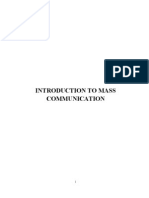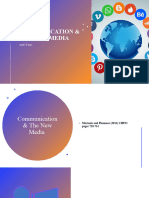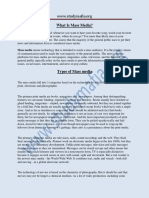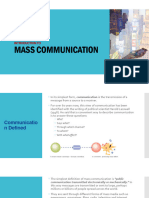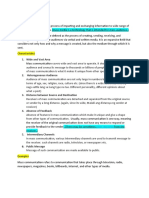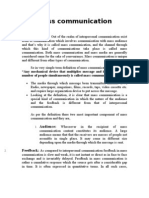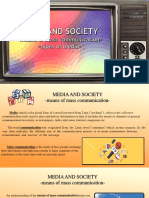0 ratings0% found this document useful (0 votes)
250 views7 pagesNature and Functions of Mass Communication
Mass communication
Uploaded by
zs596778Copyright
© © All Rights Reserved
We take content rights seriously. If you suspect this is your content, claim it here.
Available Formats
Download as PDF or read online on Scribd
0 ratings0% found this document useful (0 votes)
250 views7 pagesNature and Functions of Mass Communication
Mass communication
Uploaded by
zs596778Copyright
© © All Rights Reserved
We take content rights seriously. If you suspect this is your content, claim it here.
Available Formats
Download as PDF or read online on Scribd
You are on page 1/ 7
MODULE II
DEFINING MASS COMMUNICATION
Objectives
This unit will introduce
© Components of mass communication
* Channels of mass communication
‘* The process of mass communication
+ Nature of mass communication
* Functions and dysfunctions of mass communication
+ Types of mass media
Introduction
We leamt to define communication, identify its elements and categorize the process
based on the number of persons involved in it. Of the above mentioned types of communication,
our focus is on mass communication. In this unit, we will learn the various aspects of mass
communication, which is the thrust area of this programme.
Components of Mass Communication
For better understanding of the nature of mass communication, we should analyze its
two basic components : the mass and the communication media.
The Mass
The concept “mass” in mass communication is defined as a large, heterogeneous,
assorted, anonymous audience.
‘Large’ means we can’t exactly count the number of the members of audience, It is
relatively large but it doesn’t mean that the audience includes all people.
‘Heterogeneous’ means the audience of mass media includes all types of people - the rich,
the poor, farmers, bureaucrats, politicians and so on.
‘Assorted’ means the audience of mass media is not necessarily limited to a particular
geographical sector. They may be scattered everywhere. For example, a newspaper may have a
reader in every nook and corner of the world.
‘Anonymous’ means we can’t specifically identify a reader of a newspaper of newspaper
with his certain characteristics. Today he may be reader of a particular newspaper. Tomorrow, he
may change his media habit. Anybody at any time may be a member of mass media audience.
The channels of communication that produce and distribute news, entertainment content,
visuals and other cultural products to a large number of people. Mass media can be classified in
to three major groups on the basis of their physical nature.
Introduction to Mass Communication Page 17
School of Distance Education
They are:
* Print Media like newspaper, magazines and periodicals, books etc.
* Electronic like radio, cinema, television, video and audio records
* Digital Media like CD RoMs, DVDs and the Internet facilities.
Mass Communication Process
How does mass communication work can be well explained in linear model of mass
communication?. According to this traditional concept, mass communication is a component
system made up of senders ( the authors, reporters, producers or agencies) who transmit
messages ( the book content, the news reports, texts, visuals, images, sounds or advertisements)
through mass media channels ( books, newspapers, films, magazines, radio, television or the
Internet) to a large group of receivers ( readers, viewers, citizens or consumers) after the filtering,
of gatekeepers ( editors, producers or media managers) with some chance for feedback (letters to
editors, phone calls to news reporters, web-site postings or as audience members of talk shows or
television discussions). The effect of this process may formation of public opinion, acceptance of
a particular cultural value, setting the agenda for the society and the like.
‘A simple linear model of mass communication situation can be represented with the
iagram given below.
Reporter Report Media Audience
J
Feedback
Nature of Mass Communication
From the above model of mass communication, it is easy to identify the following
features of mass communication.
1. Mass communication experience is public one. It means that anybody can be a part of
this communication process at any time without much effort or permission.
2. It is a mediated communication act. Nature of the media involved in the process
defines the mediation in mass communication. For example, television can transmit a
news instantly as it is a fast medium, newspaper takes to bring the same news report
to the public because of its limitations. This is how nature of the media defines the
mediation process in mass communication.
Introduction to Mass Communication Page 18
School of Distance Education
3. Mass communication is filtered communication. This filtering processing is called
gatekeeping. For example, a news report in a newspaper or on a television channel
filtered or controlled at different level by reporter, sub editor, news editor, editor.
4, It is the most complicated form of communication as it involves complex technology
like satellites digital networks, management structure, marketing chain ete.
5. Mass communication can alter the way the society thinks about events and attitudes.
6. Mass communication experience is transient. It means that once you used_a message (
for example, a news report or a film) you may not use it again. The message is meant
to be used once and it is gone. Who will read yesterday's newspaper?
7. Mass communication is most often remains as one-way communication. As receivers,
how many of us write letters to editor (sender)? A very few. But, in interpersonal
communication, senders and receivers are in active conversation sending feedback to
each other.
8, Unlike other communicators, mass communicators can’t see their audience. Karan
Tapar or Pranoy Roy, the leading television personalities in India know that their
programmes are watched by millions of Indians. But, they can’t see how people
respond or react while watching their presentations. That’s why they can’t change the
style of presentation or mode of communication instantly as we do in interpersonal or
group communication.
Mass Media
Mass media influence our daily life more than any other cultural institution. They are our
main sources of news and entertainment. They define our purchase decision, voting, behavior,
academic achievement and so on. Because of this all-encompassing impact of mass media,
politicians, businessmen and government agencies depend on media to influence people. During
election time, we witness politicians spending millions of rupess for political campign through
mass media. Business firms across the world spend billions of dollars to market their products
with the help of mass media advertisements. We are informed of the policies of our governments
through newspapers and electronic media. Likewise, we people need mass media to express our
needs, complaints and wishes to the authorities. In short, role of mass media in our society is
omnipresent.
Defining Mass Media
According to Wilbur Schramm ‘a mass medium is essentially a working group organized
around some device for circulating the same message, at about same time, to a large number of people’.
From this definition, let us know that there is a well organized system behind each mass
medium. For example, a newspaper is produced everyday with the collective efforts of a lot of
people using various information sources ranging from local reporters to international news
agencies. Same is the case of distribution of the newspaper also, Everybody from circulation
manager to local newspaper boy is actively engaged in smooth circulation of each copy of a
newspaper. Moreover, every county has its own policy, laws, and telecommunication systems to
facilitate mass media. In this sense, the production of a mass medium is the result of a well
organized system.
Introduction to Mass Communication Page 19
School of Distance Education
And, the messages are disseminated to a large number of people ie. mass. They are called
the audience. No media can sustain without a sufficient audience. We learned the characteristics
of mass audience in the earlier unit.
The definition again talks about devices of circulating messages. These devices are
technological means through which messages are communicated to the audience. Devices
include printed documents, television, radio, DVD, cassettes, the internet ete.
Types of Mass Communication
Mass media can be categorized according to physical form, technology involved, nature
of the communication process etc. Given below are the major categories of mass media.
Print Media
Johannes Gutenberg’s invention of the moveable metallic type in the fifteenth century
paved the way for proliferation of the print media. The printing press using moveable types
introduced the method for mass production of texts. Before the invention of the printing press,
books were expensive materials affordable only for the aristocrats and royal families. Printing
reduced the cost of books and made them available to the common men also. Rapid duplication
of multiple copies of handy texts led to the innovation of modern newspapers.
Print Media include
© Newspapers
‘+ Magazines
© books
© other textual documents
Electronic Media
The history of electronic mass media starts with the invention of radio by Marconi. The
radio station was set up in Pittsburg, New York and Chicago in the 1920s. Following the
USA, European countries also started radio stations for broadcasting news and entertainment
content. The colonial powers like Briton and France set radio stations in Asian and African
countries in the early years of 20% century. The next step in electronic communication media
history was the invention of cinema. Following, cinema, television broadcasting was initiated in
the US on experimental basis during 1920s. But, the dramatic impact of television as a mass
medium began in 1950s. Parallel to these, recording, industry was also boomed in the western
countries. In short, the term electronic media mainly include:
* Radio
* Movies
© Television
* Audio and Video records
Introduction to Mass Communication Page 20
School of Distance Education
New Media
Online and digital means of producing, transmitting and receiving messages are called
new media. The term encompasses computer mediated communication technology. It implies the
use of desktop and portable computers as well as wireless and handheld devices. Every company
in the computer industry is involved with new media in some manner. The forms of
communicating in the digital world include
*¢ =CD-RoMs
¢ DVDs
+ Internet facilities like World Wide Web, bulleting boarding, email etc.
Functions of Mass Media
As mentioned earlier, mass media have pervasive effects on our personal and social life.
The role and scope of mass media in our society are in the following areas:
* Information
© Education
* Entertainment
* Persuasion
Information function
Mass media carry a lot of information which are essential for our day to day life. We
know exam results, weather forecasts, current affairs, traffic regulations, last dates, precautions,
government policies etc. from mass media. The core of — media's information function is
performed by the media content called news. The place or time dedicated for news in a mass
media is called news hole. News is the most consumed item of any media. News can be defined
as reports on things that people want or need to know. Information should be accurate, objective
and complete. Biased or incomplete reports will keep the audience away from the media.
Advertising is also mass media's information function. We get much useful information
from classified advertisements.
Education function
Information is different from education. Education is systematically organized information
with predefined objectives. The primary source of education in our society is schools or colleges. Media
also perform the functions that educational institutions do. Media are life-long educators for the society.
They give us comprehensive knowledge of selected topics. Non-news content or news-based content
like editorials, articles, columns in newspapers provide us with complete idea of a subject. Health
Magazines, IT magazines are also examples for education through media. Recently, mass media in
Kerala directly participate in our educational system by publishing educational supplements for
school-goers . Padippura of Malayala Manorams, Kutty.com of Mathrubhumi, Velicham of
Madhyamam, Kilivatil of Deshabhimani are examples. Moreover, we have a number television
channels dedicated for mass education. Victors of IT @ School Project of Kerala Government, Vyas
Channelr of Consortium of Educational Communication under University Grants Commission,
Gyandarsan of Doordarshan are some of such efforts.
Introduction to Mass Communication Page 21
School of Distance Education
Entertainment function
Irrespective of their type, mass media are wonderful entertainers. All media have
entertainment content. Newspapers publish cartoons, comics, puzzles, special weekend
supplements for amusing people. Lion share of magazine content such as short stories, novels,
satires and cartoons are for entertainment. Movies are another big stock for entertainment.
‘Audio-Visual media such as television and radio are also primarily concentrate on entertainment
function through their programmes based on sports, film, and fashion shows etc.
Persuasion
Persuasion means influencing attitudes or opinions. Mass media have many ways to
persuade people. Most people form their opinion from information they get from mass media
Media have direct and indirect methods for persuasion. For public opinion formation, mass
media use editorials, news analysis and commentaries. In such cases, the purpose is clear and
direct, The most obvious method of persuasion is advertising. Advertisements are direct
methods to influence purchasing behaviour of the public. Some media report events hiding their
vested interests in news, Such biased, subjective reports are for persuading people to form
favourable attitudes towards them or their interests. Opinionated news is an undirected method
of persuasion. It’s against the ethics of responsible journalism. News and opinion should be
given separately.
According to western media scholars like Harold Laswell, mass media, be print or
electronic, have the following functions:
Surveillance of the environment
Mass media observe the society and its activities and report them to make people aware
of their socio-cultural environment. In other words, we as social animals are always under the
close observations of mass media. Media are our watchdogs. It always watches who do good
things and who do bad things, and report them to encourage or correct our deeds. Reports about
corruptions are good example. Considering this watchdog function of mass media, we call the
media as the Fourth Estate of our democratic political system. The other estates are Legislative,
Judiciary and Executive.
Transmission of heritage
Mass media are the bridge between our past and present. They report day to day affairs
which will become history of tomorrow. The best records of moder history are newspapers of
yesteryears. We get our cultural tradition from history and we follow the best of them. In
keeping our culture flowing, media play a vital role. It advises us which part of our culture is
good and to be followed and which is bad and not to be followed.
Interpretation of information
Mass media provide us with information from every nook and corner of the world. They
dio not just report facts and figures of the events, rather they interpret events to make us aware of
what happens, and why, where, when and how it happens. Media interpretation may be biased
or not. But, it helps develop our views towards an event or object or personality. Every media
report is an analysis and one version of the fact. There may be another versions and analysis.
————
Introduction to Mass Communication Page 22
School of Distance Education
Prescription for conduct
How should we behave in a society? What should be our approach towards something
important to the society? What is good for social life? As a member of a larger social system, we
face these questions every now and then. In most cases, mass media provide us answers. During
the election time, we are confused of electing a candidate. But, news coverage of political policies
and leaders of various parties give us an insight that helps us take decisions. This is how media
prescribe our political conduct. So do the advertising. Which product or service is better? Which
is suitable to our budget? We depend on advertisements before taking purchase decisions.
Catalyst for Development
Ina country like India, media's role in national development is highly important. Media's
contributions to national development are mainly in two ways : As advocates for development
and as carriers of development messages. Mass media find out problems faced by people in
different walks of their life and make the administrators aware of them. Most often, media report
such events and further campaign to get the grievances redressed. On the other hand, media
make people aware of their rights, government subsidies, development policies and the merits
and demerits of adopting or practicing them for better life. Government controlled media
perform these duties better than the private media do. This development orient function of
media is termed as Development Communication. Development Communication has been
recognized asa special area in communication study and research.
Nature of Mass Communication
From the above model of mass communication, it is easy to identify the following
features of mass communication.
1. Mass communication experience is public one. It means that anybody can be a part of this
communication process at any time without much effort or permission.
2. Ibis a mediated communication act. Nature of the media involved in the process defines the
‘mediation in mass communication, For example, television can transmit a news instantly as it is a
fast medium, newspaper takes to bring the same news report to the public because of its
limitations. This is how nature of the media defines the mediation process in_mass
communication.
3, Mass communication is filtered communication. ‘This filtering processing is called gatekeeping.
For example, a news report in a newspaper or on a television channel filtered or controlled at
different level by reporter, sub editor, news editor, editor:
4, Itis the most complicated form of communication as it involves complex technology like satellites
digital networks, management structure, marketing chain etc.
5, Mass communication can alter the way the society thinks about events and attitudes,
6. Mass communication experience is transient. It means that once you used a message
(for example, a news report or a film) you may not use it again, The message is meant to be used.
once and it is gone. Who will read yesterday's newspaper?
7. Mass communication is most often remains as one-way communication. As receivers, how many
of us write letters to editor (sender)? A very few. But, in interpersonal communication, senders
and receivers are in active conversation sending feedback to each other.
8. Unlike other communicators, mass communicators can't see their audience. Karan Tapar or
Pranoy Roy, the leading television personalities in India know that their programmes are
watched by millions of Indians. But, they can’t see how people respond or react while watching,
their presentations. That's why they can’t change the style of presentation or mode of
communication instantly as we do in interpersonal or group communication
Introduction to Mass Communication Page 23
You might also like
- Lecture 1 (Unit - 2 Mass Communication - Concept and Definition)No ratings yetLecture 1 (Unit - 2 Mass Communication - Concept and Definition)9 pages
- Introduction To Mass Communication TheoriesNo ratings yetIntroduction To Mass Communication Theories6 pages
- Mass Communication Module-Track Changes AcceptedNo ratings yetMass Communication Module-Track Changes Accepted36 pages
- Mass Communication Concepts Processes PDFNo ratings yetMass Communication Concepts Processes PDF77 pages
- Meaning, Def, Characterstics and Elements of MCNo ratings yetMeaning, Def, Characterstics and Elements of MC4 pages
- Understanding Mass Media and Mass CommunicationNo ratings yetUnderstanding Mass Media and Mass Communication12 pages











